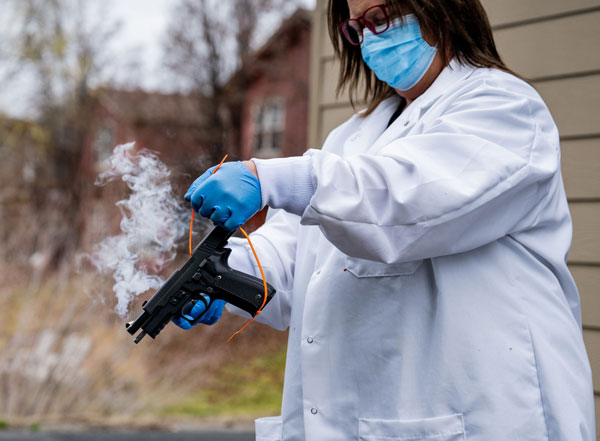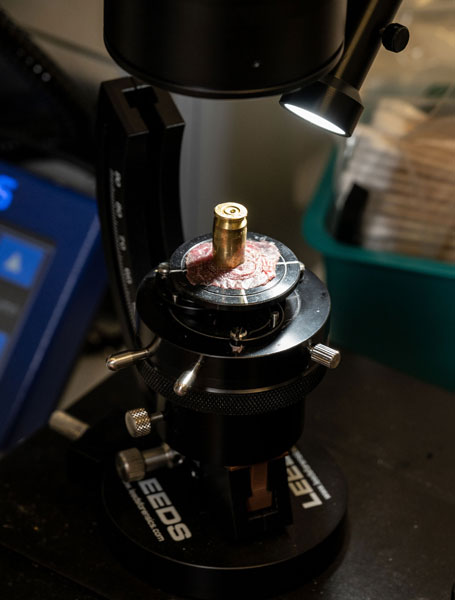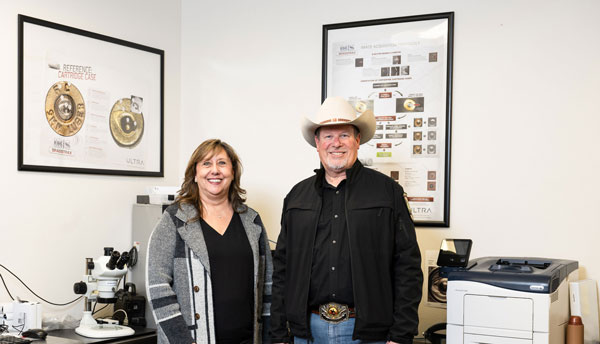How a collaborative regional forensics lab is fast-tracking violent crime investigations throughout the Yakima Valley.
By Jennifer Krazit
After a drive-by shooting took place in a small Yakima Valley community, an officer pulled over a vehicle of interest and seized a firearm. That firearm was sent to the Yakima Valley Local Crime Lab (YVLCL) in nearby Zillah. After it was test-fired and results were entered into the National Ballistic Information Network (NBIN, a national ballistics database of firearms evidence), an association to the drive-by shooting was established and an investigative lead notification was issued, allowing local law enforcement to follow up with the driver for questioning.

Caption: A Yakima Valley Local Crime Lab technician lifts fingerprints from a firearm. (Photo by Chona Kasinger)
Prior to the YVLCL opening in August 2023, a firearm like this would have been shipped to the Washington State Patrol Crime Lab (WSPCL) in Spokane, which serves 260 law enforcement agencies statewide. Due to a backlog, it could have taken up to six months for an investigative lead notification to have been issued. “At that point, a case is likely to have gone cold,” according to Crime Lab Manager Kathy Geil.
The lab is the very definition of a team effort. It’s managed by the Yakima Valley Conference of Governments (YVCOG), a regional government and coordinating body that fosters collaboration and cooperation between Yakima County, 14 cities in the Yakima Valley, 11 municipal police departments, the Yakima County Sheriff’s Office, and the Yakima Valley Prosecuting Attorney’s Office.
Initial funding came in the form of an ARPA grant that had been allocated to Yakima County, along with some additional funding from the Washington Department of Commerce and a few local community grants from the state and the Yakima Nation. In addition, member communities pay a contribution based on their populations. Sharing the remainder of unfunded operating costs among all stakeholders made bankrolling the lab, which would have been prohibitive for any single jurisdiction, surprisingly affordable. “There’s no way they could hire the staff and purchase the equipment on their own, but by coming together, they were able to do that,” says YVCOG Executive Director Christina Wickenhagen.

A bullet sits on a microscope waiting to be analyzed at the Yakima Valley Local Crime Lab. (Photo by Chona Kasinger)
In addition to entering data from test firings into the NIBIN to search for associations to other shootings, YVLCL technicians (serving 12 law enforcement agencies) conduct cell phone data extractions, crime mapping analysis, and Rapid DNA sample acquisitions. Within days of an event, this information can help law enforcement personnel understand if their leads are plausible or if they need to look in another direction. By bringing criminal forensics capabilities directly to the Yakima Valley, the lab enables local law enforcement to act on leads months or even years faster than waiting for evidence to get processed by the WSPCL. By reducing the volume of evidence sent to the WSPCL, that crime lab now can focus on cases going to trial, enabling law enforcement to directly respond to and address rising violent crime rates in the region.

Yakima Valley Conference of Governments Executive Director Chris Wickenhagen and Yakima County Sheriff Robert Udell. (Photo by Chona Kasinger)
“The Yakima Valley is the gang capital of the Northwest, and a lot of illegal drugs pour through our valley,” says Sheriff Robert Udell, noting that in 2023 Yakima County had on average 1.71 officers per thousand residents, compared to the national average at 2.4. “We have above average violent crime and property crime in Yakima County. We also have below average officer rates. We needed help.”
We have above average violent crime and property crime in Yakima County. We also have below average officer rates. We needed help.
In addition to speeding up evidence processing, the initiative has streamlined inter-agency collaboration throughout the valley. “There are 13 different law enforcement agencies in this county, and we were all doing our own thing,” says Udell. Since the lab opened, the sheriff has created a SWAT team involving jurisdictions throughout Yakima County and is looking to create a countywide communication system for all first responders, “so we’re all using the same equipment and speaking the same language.”
Wickenhagen believes the lab can be used as a template for similar initiatives around the state. When other communities have approached her for advice, she’s eager to provide guidance but is quick to share one key lesson: “We were successful because our cities were willing to put aside their individual authority to come together and truly collaborate.”